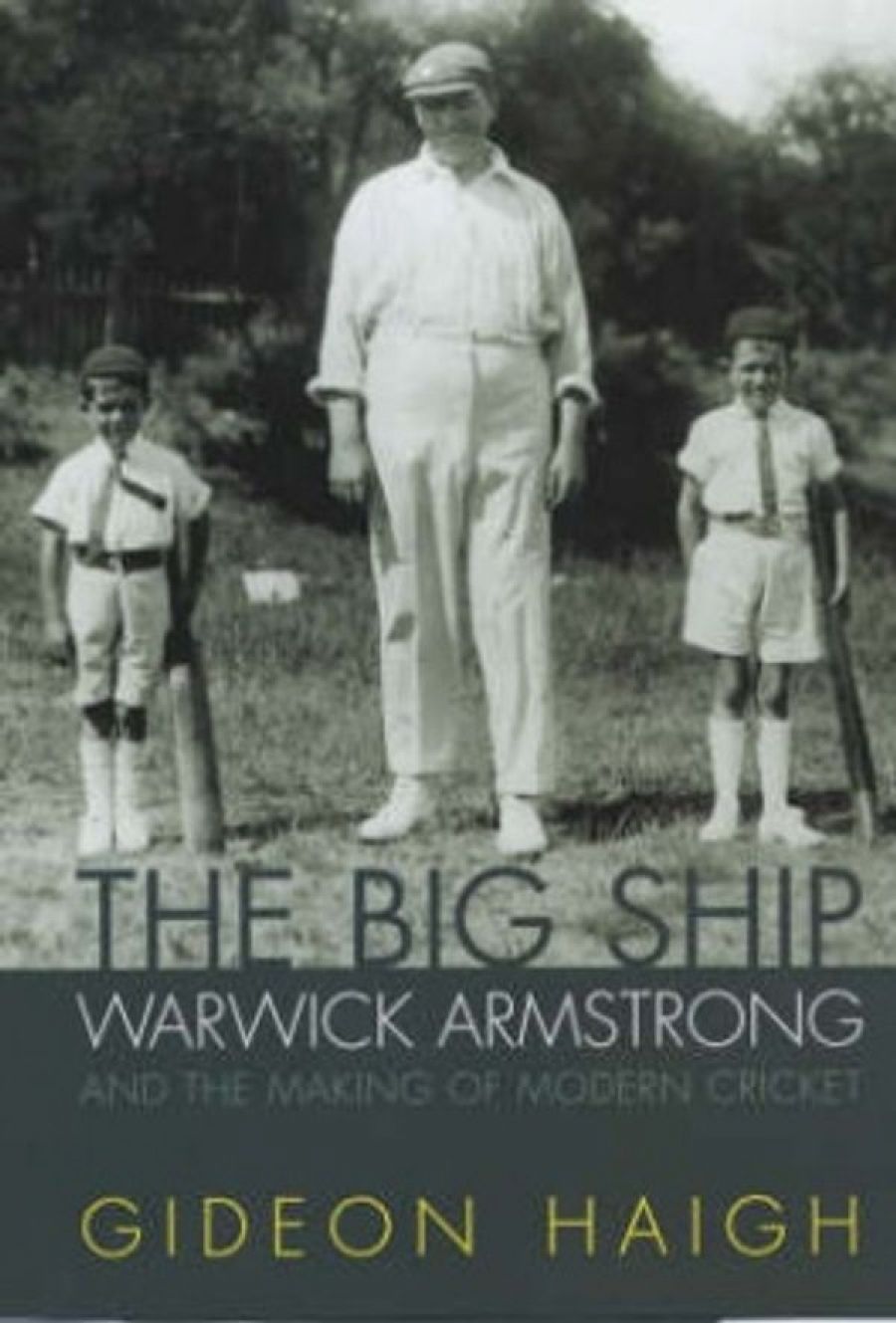
- Free Article: No
- Contents Category: Sport
- Review Article: Yes
- Article Title: Summer Delights
- Online Only: No
- Custom Highlight Text:
New Year’s Day 2002 marks the centenary of Warwick Windridge Armstrong’s Test cricket début for Australia. At the age of twenty-two, the promising all-rounder carried his bat in both innings on the Melbourne Cricket Ground against Archie MacLaren’s English side. Almost twenty years later, a much heavier and more famous Armstrong, then aged forty-one and nicknamed ‘The Big Ship’ because of his size, captained Australia for the tenth time in his fiftieth and last Test match, played at The Oval in London.
- Book 1 Title: The Big Ship
- Book 1 Subtitle: Warwick Armstrong and the making of modern cricket
- Book 1 Biblio: Text, $60 hb, 440 pp
- Book 1 Readings Link: https://www.booktopia.com.au/the-big-ship-warwick-armstrong-and-the-making-of-modern-cricket-gideon-haigh/book/9781743315170.html
That game was the second successive drawn Test under his leadership, the previous eight – five in Australia and three in England – having all resulted in resounding victories for his team. His record as an unbeaten captain has not been equalled by any other Australian who has led the Test side more than twice. That final Test appearance by Armstrong has become celebrated for another reason: the often-told story that the burly skipper, exasperated by the slow English batting and the inevitability of a draw, passed his time in the outfield reading a newspaper. Not so, says Gideon Haigh, who finds evidence that the legend arose after Armstrong merely picked up a sheet of newspaper that was blowing across the ground and glanced at its masthead before disposing of it.
This is not to say that Warwick Armstrong was incapable of dramatising his feelings about unsatisfactory aspects of the game to which he dedicated so much of his life. He was fearless and at times reckless in taking stands against what he regarded as the unfair or unjust conduct of cricket officials. Again and again, to his own cost, he championed what he understood to be the rights of players who, in his early days in the game, managed their own affairs, including team selections and tours. This was the way it was during much of the period, from the mid-1890s to World War II, labelled the Golden Age of cricket. But change was in the air, with the advent of national Boards of Control and the diminishing powers of localised institutions like Armstrong’s beloved Melbourne Cricket Club. Haigh’s well-documented account of these developments is one of the features of this long biography.
Warwick Armstrong’s name, especially in his home state, Victoria, is well-remembered, but many of the details of his life and achievements, on and off the field, are not well-known. He is recalled as a forthright and controversial sporting figure, with a win-at-all-costs approach to cricket, but comparatively little is known about his private persona. It is pleasing that such an accomplished cricket writer and meticulous researcher as Gideon Haigh undertook to meet the need, although even he gives the impression that he is dealing with one of the game’s more enigmatic and unfathomable characters.
Appearing so soon after the death of Bradman and the publishing of so much material about him, The Big Ship is a reminder that the history of Australian cricket did not begin in 1928, with the Don’s first appearance on the Test scene. Some comparison between the Test histories of the two players is, however, unavoidable. Each career spanned two decades, included one instance of omission from the side, was interrupted by a world war and concluded with a triumphant visit to England. Bradman and his ‘Invincibles’ achieved in 1948 what Armstrong, to his great disappointment, had failed to accomplish in 1921 because of two late losses in minor games – a tour unblemished by defeat.
A comparison between the two men as batsmen is, of course, to Bradman’s advantage, given his matchless statistics, but it may be fairer to liken Armstrong to such great Australian all-rounders as Miller, Benaud and Davidson. He surely belongs in their august company.
In retirement, Armstrong was a successful whisky merchant and, as a journalist, a sometimes acerbic critic of other cricketers, including Bradman (‘a cricket cocktail’), especially during the notorious Bodyline series. It was his opinion that Bradman was no better than several other top batsmen, notably his old team-mate Victor Trumper.
Non-lovers of cricket could find that this book tells them more about Warwick Armstrong and his times than they wish to know. To cricket fans, however, it offers a deep mine of fascinating information, anecdotes, and material for trivia games. Who knew, for example, that Armstrong is only one of three batsmen who have hit a ball over the stand at the Radcliffe Road end at Trent Bridge? Or that he played thirteen VFL games, rucking for South Melbourne, including the 1899 premiership decider, won by Fitzroy by one point? Or that two bridges in Kyneton, the town where he was born, were this year named after him? Or that he once scored 438 in 445 minutes for Melbourne against University? On virtually every page of this absorbing biography, Gideon Haigh provides such offerings for the summer-time delectation of cricket’s devotees.


Comments powered by CComment